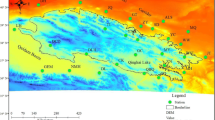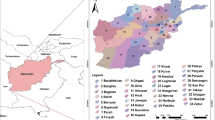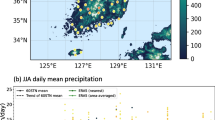Abstract
In any given region, climate change can be manifested in the form of various characteristics of climatic elements. In the present study, the frequency of different duration of rainy days was examined to investigate the precipitation variations as a sign of climate change. To this end, gridded precipitation data were used from 1971 through 2016, and days with more than 1 mm of precipitation were considered rainy days. According to the rainy days’ frequency, it was revealed that during the study period, 1 to 36 days of duration occurred in the country. The 1-day duration had the highest frequencies and covered the vastest areas, while 36-day duration had the lowest frequencies and covered the minor areas. Accordingly, the 1-day duration played the most significant role in annual precipitation. The proportion of these rainfall events in some country’s dry and semi-dry parts was more than 80%. The findings also revealed an increased frequency of short-term, especially 2-day duration, in large parts of the country and a decrease in the long-term duration. The results showed that latitude and longitude had the most significant impact on the frequency distribution of the duration of rainy days. Latitude had a direct effect (excluding the 1-day duration of annual precipitation), and longitude had an inverse effect (except the 1-day duration of annual precipitation) on the precipitation duration.






Similar content being viewed by others
Data availability
The data on daily precipitation was provided from the Islamic Republic of Iran Meteorological Organization (IRIMO) which has been described in detail under the heading of “Section 2.2” in this manuscript.
Code availability
MATLAB code was used in this study for analyzing the data and preparing the required maps of the study area. The code is written according to the method described in detail under the heading of the “Section 2.3”.
References
Agha Razi H, Telvari A, Davoudi Rad AA (2007) Drawing depth–area–duration in Markazi Province. Pajouhesh Va Sazandegi 20:94–98
Alijani B (1996) Climate of Iran. Payam Noor University Press, Tehran
Alijani B (2008) Effect of the Zagros Mountains on the spatial distribution of precipitation. J Mt Sci 5:218–231. https://doi.org/10.1007/s11629-008-0126-8
Alijani B, O’Brien J, Yarnal B (2008) Spatial analysis of precipitation intensity and concentration in Iran. Theor Appl Climatol 94:107–124. https://doi.org/10.1007/s00704-007-0344-y
Alijani B, Mahmoudi P, Shahvazni A, Mohammadi A (2014) Investigating the probability of rainy days’ duration in Iran. Geogr Environ Plann 25:N 56
Asakereh H (2006) Climate change. Zanjan University Press, Zanjan
Asakereh H (2008) Kriging application in climatic element interpolation a case study: Iran precipitation in 1996.12.16. Geography and Development 6:25–42. https://doi.org/10.22111/gdij.2008.1241
Alizadeh A (2009) Principles of applied hydrology. Imam Reza University Press, Mashhad
Asakereh H (2011) Foundations of statistical climatology. Zanjan University Press, Zanjan
Asakereh H (2013) Analyses the trend of dry and wet winds in Zanjan. Geography and Development 11:47–56. https://doi.org/10.22111/gdij.2013.793
Asakereh H, Tarkarani F (2020) Some descriptive features and long-term changes of dry season over Iran. Geogr Dev 18(58):113–132. https://doi.org/10.22111/gdij.2020.5324
Asakereh H, Jahanbakhsh S, Ashrafi S (2019) On the frequency changes of cyclones affecting precipitation in the Rood Zard basin, Iran. Arab J Geosci 12:413. https://doi.org/10.1007/s12517-019-4523-9
Asakereh H, Masoudian SA, Tarkarani F (2020) Long - term trend detection of annual precipitation over Iran in relation with changes in frequencies of daily extreme precipitation. J Geography and Environmental Hazard 9:123–143. https://doi.org/10.22067/geoeh.2021.67028.0
Asakereh H, Masoudian SA, Tarkarani F (2021a) A discrimination of roles of internal and external factors on the decadal variation of annual precipitation in Iran over recent four decades (1975–2016). Phys Geogr Res 53:91–107. https://doi.org/10.22059/jphgr.2021.304776.1007529
Asakereh H, Masoudian SA, Tarkarani F (2021b) An investigation of decadal variation of Iran precipitation over four decades (1976-2016). Geogr Plan 25:187–202. https://doi.org/10.22034/gp.2020.41308.2680
Behyar MB, Khazaei M, Ghaemi H (2013) The analysis of precipitation time regime in Great Karoon Basin. GeoRes 28(1):1–12
Bichet A, Diedhiou A (2018) West African Sahel has become wetter during the last 30 years, but dry spells are shorter and more frequent. Clim Res 75(2):155–162. https://doi.org/10.3354/cr01515
Box GEP, Jenkins GM, Reinsel GC, Ljung GM (2016) Time series analysis forecasting and control, 5th edn. John Wiley & Sons Publication, London
Darand M (2018) Spatial analysis of precipitation persistency in Kurdistan Province. Geography and Development 52:247–266. https://doi.org/10.22111/gdij.2018.4125
Dostkamyan M, MohammadiBigdeli F, kohpayehi N, (2015) The analysis of monthly moisture advection changes in Iran’s atmosphere over the recent half-century. Res Geogr Sci 15(39):139–152
Douguedroit A (1987) The variation of dry spells in Marseilles from 1865 to 1984. J Climatol 7:541–551. https://doi.org/10.1002/joc.3370070603
Duan Y, Ma Z, Yang Q (2017) Characteristics of consecutive dry days variations in China. Theor Appl Climatol 130:701–709. https://doi.org/10.1007/s00704-016-1984-6
Fatahi I, Hejazi Zadeh Z (2006) Temporal and spatial air masses and its application in monitoring dry and wet periods (spells) in southwest basins of Iran. Geogr Res 21:99–120
Ghafouriam R, Telvari A (2010) Determination of depth – area – duration rainfall curves and relationships in Khorasan Province. Range and Watershed Management 63:219–234
Gholizadeh MH, Hamidi S (2020) The evaluation of rainfall duration variability in Kurdistan Province. Geography and Planing 24:197–217. https://doi.org/10.22034/gp.2020.10541
Jahanbakhsh S, Ashrafi S, Asakereh H (2021) Examining decadal changes in cyclones associated with precipitation in the Zard Rud basin. Geography and Planing 75:101–112. https://doi.org/10.22034/gp.2021.10842
Kavyani MR, Alijani B (2001) The foundations of climatology. Samt Press, Tehran
Kutiel H, Trigo RM (2014) The rainfall regime in Lisbon in the last 150 years. Theoret Appl Climatol 118(3):387–403. https://doi.org/10.1007/s00704-013-1066-y
Lashkari H, Mohammadi F (2019) Investigation of rainfall variation of Sudan low during the historical process in southwestern Iran. Physical Geography Research 51:373–387. https://doi.org/10.22059/jphgr.2019.272706.1007323
Lázaro R, Rodrigo FS, Gutirrez L, Domingo F, Puigdefáfragas J (2001) Analysis of a 30-year rainfall record in semi-arid SE Spain for implications on vegetation. J Arid Environ 48:373–395. https://doi.org/10.1006/JARE.2000.0755
Liu C (2011) Rainfall contributions from precipitation systems with different sizes, convective intensities, and durations over the tropics and subtropics. J Hydrometeorol 12:394–412. https://doi.org/10.1175/2010JHM1320.1
Mansuri S, Doostan R (2019) Atmospheric patterns of rainfall duration in west of Iran. Phys Geogr 12:141–159
Masoudian SA (2008) On precipitation mapping in Iran. J Humanit 30(2):69–80
Masoudian SA, Kavyani MR (2008) Climatology of Iran. Isfahan Univercity Press, Isfahan
Masoudian SA, Rayatpishe F, Keykhosravi Kiani MS (2015) Introducing the TRMM and Asfezari precipitation database: a comparative study. Iranian Journal of Geophysics 4:15–31
Mudelsee M (2019) Trend analysis of climate time series: a review of methods. Earth Sci Rev 190:310–322. https://doi.org/10.1016/j.earscirev.2018.12.005
Naseri M, Modarres R (2009) Dry spell trend analysis of Isfahan Province. Iran. Int J Climatol 29:1430–1438. https://doi.org/10.1002/joc.1805
Nazaripour H (2014) Regions of Iran with persistence of precipitation. Geography and Development 12:195–208. https://doi.org/10.22111/gdij.2014.1718
Nazaripour H, Karimi Z (2013) Detection changes in precipitation daily Persistence's share in the supply of Iran's rainy days and precipitation amount. J Geogr Sci 12:53–75
Nazaripour H, Khosravi M, Masoodin SA (2011) Spatial patterns of importance of Iranian rainfall persistency. Arid Regions Geographic Studies 1(3):37–58
Nunn R (1929) Duration of rainfall at Baltimore, MD. Mon Weather Rev 752:50–52
Rahim Zadeh F, Hedayati Dezfuli A, Pour Asgharian A (2011) Assessments of the process and mutation of limit indices of temperature and precipitation in Hormozgan Province. Geography and Development 9(21):97–116. https://doi.org/10.22111/gdij.2011.583
Ratan R, Venugopal V (2013) Wet and dry spell characteristics of global tropical rainfall. Water Resour Res 49:3830–3841. https://doi.org/10.1002/wrcr.20275
Romero R, Guijarro AJ, Ramis C, Alonso S (1998) A 30-year (1964–1993) daily rainfall data base for the Spanish Mediterranean regions: first exploratory study. Int J Climatol 18:541–560. https://doi.org/10.1002/(SICI)1097-0088
Shands AL (1947) Maximum observed rainfalls in the United States for durations to 72 hours and areas to 100000 square miles. Bull Am Meteorol Soc 28:233–236
Singh N, Ranade A (2010) The wet and dry spells across India during 1951–2007. J Hydrometeorol 11:26–45. https://doi.org/10.1175/2009JHM1161.1
Sotoudeh F, Alijani B, Saligheh M, Akbari M (2019) The influence of Zagros Mountains on Iran's rainfall cyclones. Physical Geography Research 50(4):639–653. https://doi.org/10.22059/jphgr.2019.245032.1007142
Vaittinada Ayar P, Mailhot A (2021) Evolution of dry and wet spells under climate change over north-eastern North America. J Geophys Res Atmos 126:e2020JD033740. https://doi.org/10.1029/2020JD033740
Vinnarasi R, Dhanya CT (2016) Changing characteristics of extreme wet and dry spells of Indian monsoon rainfall. J Geophys Res Atmos 121:2146–2160. https://doi.org/10.1002/2015JD024310
Ye H, Fetzer EJ (2019) Asymmetrical shift toward longer dry spells associated with warming temperatures during Russian summers. Geophys Res Lett 46(11):455–462. https://doi.org/10.1029/2019GL084748
Acknowledgements
We would like to thank the Islamic Republic of Iran Meteorological Organization (IRIMO) for providing us with the daily precipitation.
Author information
Authors and Affiliations
Contributions
We, the authors, contributed to the research. Hossein Asakereh performed the study conception, design, and data analysis. Material preparation and data collection were performed by Saeideh Ashrafi. The first draft (in Persian) of the manuscript was written by Saeideh Ashrafi. The final version of the manuscript (in English) was written by Hossein Asakereh.
Corresponding author
Ethics declarations
Ethics approval
The manuscript is original and is not submitted to another journal for simultaneous consideration neither has been published elsewhere in any form or language (partially or in full). Results are presented clearly, honestly, and without fabrication, falsification, or inappropriate data manipulation. No data, text, or theories by others are presented as if we are the author’s own.
Consent to participate
We, the authors, understand that any information we submit for this study will be treated as confidential and that we have all contributed to the research.
Consent for publication
We, the authors, provide our consent for this research to be published in the Theoretical and Applied Climatology journal, which includes maps and information within the text.
Conflict of interest
The authors declare no competing interests.
Additional information
Publisher's Note
Springer Nature remains neutral with regard to jurisdictional claims in published maps and institutional affiliations.
Rights and permissions
Springer Nature or its licensor (e.g. a society or other partner) holds exclusive rights to this article under a publishing agreement with the author(s) or other rightsholder(s); author self-archiving of the accepted manuscript version of this article is solely governed by the terms of such publishing agreement and applicable law.
About this article
Cite this article
Asakereh, H., Ashrafi, S. Variation in frequency and proportion of duration of rainy days in Iran’s precipitation. Theor Appl Climatol 151, 1257–1268 (2023). https://doi.org/10.1007/s00704-022-04352-6
Received:
Accepted:
Published:
Issue Date:
DOI: https://doi.org/10.1007/s00704-022-04352-6




